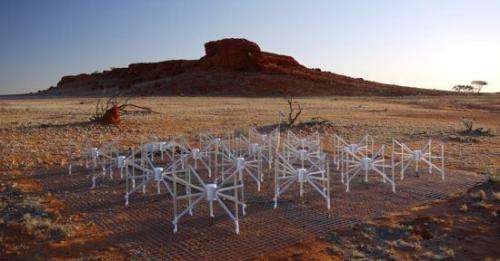This group of dipole antennas is one of 128 scattered across a 1.5-kilometer region of the Western Australian desert, which collectively are capable of high-quality imaging. Credit: Natasha Hurley-Walker
When a large radio telescope in the Australian outback was unveiled last week its improved sensitivity was immediately apparent. It transformed images of supernova remnants taken with last year's equipment from undefined blobs to glowing gas clouds.
The Murchison Widefield Array (MWA) will be used to investigate solar storms and uncover details of how the early universe formed, events that can be detected at low radio frequencies. But a UWM astrophysicist has explored an additional aspect of the telescope – its ability to track space junk, everything from defunct satellites to pieces resulting from collisions.
David Kaplan, an assistant professor of physics, has been a member of the international team working on the prototypes of the telescope and will be one of the first scientists to use it now that it's fully operational.
Though he plans to use the facility to search for rare violent events in space, Kaplan contends that the unique features of MWA make it a perfect passive radar to monitor the paths of space debris.
While standard radar uses an antenna to transmit a signal and then receive its reflection, passive radar just detects stray signals – in this case, FM radio signals – that happen to be around.
Radar to the rescue
To illustrate how it works, Kaplan has created an animation that tracks the International Space Station as it moves across the sky. FM radio waves from radio stations on Earth bounce off the ISS, and are picked up by the MWA.
"Low-frequency radio waves can be useful to look both at objects that are very far away from Earth, or very close by, like satellites," he says. "With this technology, we can look at a huge portion of the sky at once, and it can monitor debris that is as small as a meter in diameter."
With more than 21,000 pieces of orbiting space junk, scientists are increasingly concerned about collisions with satellites and other operating spacecraft. Collisions with communications satellites, for example, have the potential to disrupt communications systems on Earth.
The most powerful low-frequency telescope in the Southern Hemisphere, the MWA is the result of eight years of work by an international consortium of 13 institutions in four countries (Australia, the United States, India and New Zealand).
The wavelengths it picks up (roughly 2 meters) allow scientists to look at objects and phenomena that can't be detected clearly with other radio telescopes, in an area of the spectrum that is not well-explored.
One reason is that background noise from radio and TV stations on Earth overwhelms the faint astronomical signals. But in its remote outback area, the telescope will be removed from almost all radio-frequency interference.
Studying these waves, the MWA will provide an unprecedented view into the first billion years of the universe, says Steven Tingay, director of the MWA and professor of radio astronomy at Curtin University in Australia.
The MWA also is the first of three international precursors to the $2 billion Square Kilometre Array (SKA), an international radio telescope partly located at the MWA site that will constitute the world's largest and most powerful radio telescope when its first phase is completed in 2020. Experience gained with the MWA now will pave the way for more detailed studies with the SKA in the future.
UWM researcher on deck
The facility is an "aperture array" in which antennas are scattered across the landscape. Signals from each of the 2,048 antennas are captured and combined electronically, which means scientists can steer the telescope to a different part of the sky simply by changing the way the signals are combined.
Kaplan estimated it takes minutes for a traditional radio telescope to physically move in order to view a different part of the sky, while the MWA can accomplish the same task in 8 seconds.
"This is really only possible with modern computers," says Kaplan.
He became involved in the MWA project while a postdoctoral researcher at the Massachusetts Institute of Technology (MIT), one of the core institutions in the collaboration. His project group, which includes researchers from Curtin, the University of Syndey, MIT, Harvard/Smithsonian and the Commonwealth Scientific and Industrial Research Organisation of Australia, involves a different kind of search from the one monitoring space debris.
Kaplan's group will conduct a low-frequency survey of the galaxy to detect violent events, like exploding stars and stellar flares bigger than our sun.
The cosmic explosions he hopes to see happen rarely and without notice – at least in the small field of view available before now.
"What we're looking for are events that have been seen one or twice, but ones we really need to see 10 or 12 times to get more information," he says.
More information: www.gravity.phys.uwm.edu/~kaplan/MWA_ISS.html
Provided by University of Wisconsin - Milwaukee





















